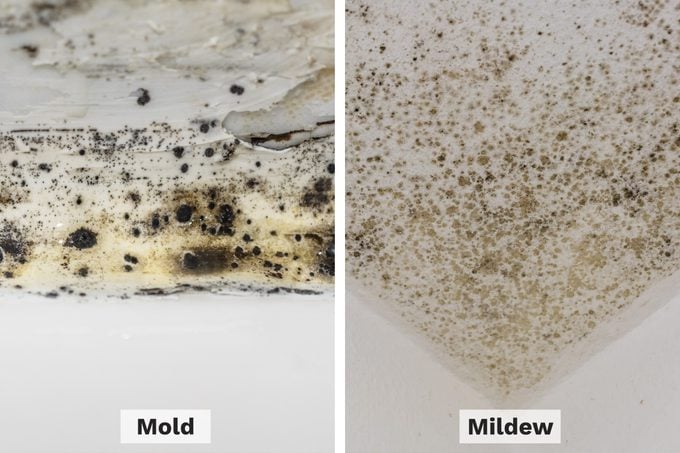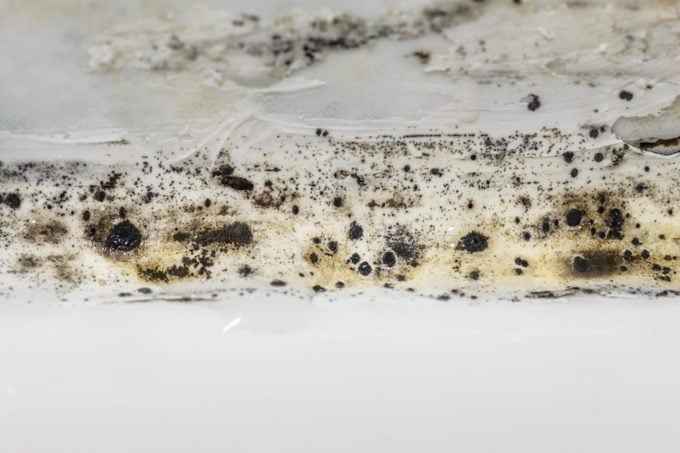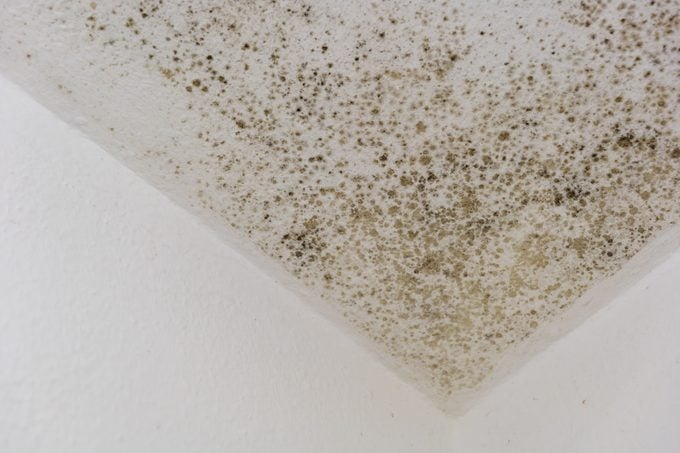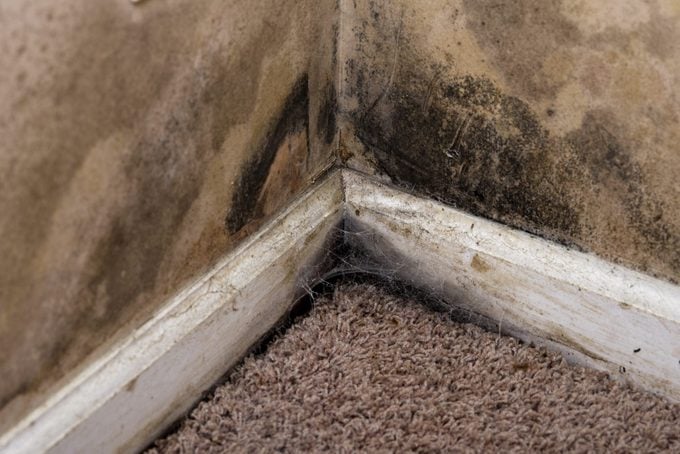Mildew vs. Mold: What’s the Difference?
Updated: Oct. 06, 2021
Here's what you need to know about identifying mold vs. mildew, cleaning it up, and preventing it from coming back.
Mold vs. mildew

You see icky black and slimy stuff in your shower, down a drain, or coming through the paint on your ceiling (yikes!), and your first reaction probably isn’t to figure out exactly what it is. The important thing is just to get rid of it before it spreads, right?
Before you grab a sponge, however, it can help to have a little more information, including whether that gunk is mold vs. mildew.
Being able to identify the ooze, and understand how it grows, can help you protect your health and successfully stop the problem.
What is mold?

Mold is any species of microscopic fungus that grows in the form of tiny threads or multicellular filaments, called hyphae.
Like other fungi, mold arises from spores, which can travel through the air or hitch rides on animals and people. No one is sure how many species of mold exist, but scientists have identified more than 100,000 types so far. Evidence of mold has been found in nearly every type of environment.
Mold can appear in many different colors, including black, red, pink, gray, and green. It may have a musty or unpleasant odor.
Moist areas with low airflow—like your basement or shower—are where mold thrives.
It feeds on a wide array of organic matter, including food, clothing, leather, paper, and even cleaning supplies themselves, like sponges and some types of cleaning spray.
If you have leaks, flooding, or other issues with moisture management in your home, mold can grow in and on the ceilings, walls, and floors.
However, molds are incredibly adaptable and can grow almost anywhere. They can grow on virtually any substance, as long as moisture is present.
(Here’s what happens if you eat mold.)
What is mildew?

Mildew is a nonscientific word that describes a particular type of mold, usually the kind that grows in a flat pattern on surfaces in homes. It’s generally a black or dark color and has a slick texture.
Many people use “mildew” and “mold” interchangeably when talking about cleaning their homes. So the question isn’t really mold vs. mildew, but rather mildew vs. other types of mold.
How mold and mildew can harm your health
Most mold is nontoxic to humans, and you likely breathe and touch way more of it than you realize. In fact, some types of mold are beneficial to people, breaking down organic matter in the soil and making certain types of cheeses extra delicious.
Still, both mold and mildew are potential health hazards lurking in your home. Here are four main ways they can be harmful to your health.
Allergies
The most common reaction people have to mold is an allergic reaction, either from touching the mold, eating it, or inhaling the spores, says Purvi Parikh, MD, an allergist with Allergy & Asthma Network and a clinical assistant professor in the departments of Medicine and Pediatrics at New York University School of Medicine.
Allergic reactions include symptoms like:
- mild: sneezing or a runny nose
- moderate: hives, rashes, or a chronic cough
- severe: anaphylactic shock, causing the airways to close and requiring immediate emergency medical help
Mold is a very common environmental allergen, and most allergists include it in standard allergy testing.
Irritation
Even people who aren’t allergic to mold may experience irritation from coming into contact with mold or mildew, according to Dr. Parikh.
Symptoms of mold irritation include watery eyes, a scratchy throat, itchy skin, runny nose, and irritation in the lungs. The irritation can exacerbate existing conditions like COPD and asthma.
Asthma
Most asthma is allergic and triggered by indoor and outdoor allergens, including mold and mildew, Dr. Parikh says.
Uncontrolled asthma can have serious and even life-threatening consequences.
A major part of keeping asthma under control is identifying exactly which substances are triggering your attacks and finding ways to remove or avoid those triggers, she says. This means people with asthma need to be particularly vigilant about mold and mildew.
Diseases
Some mold species contain mycotoxins, substances that are toxic to humans on their own.
Mycotoxins are known to cause certain diseases and illnesses in humans, including histoplasmosis (a lung infection), some cancers, skin conditions, immune disorders, kidney dysfunction, and neurological problems, according to research published in Clinical Microbiology Reviews.
Some mycotoxins are lethal and have been used as bioweapons, the researchers noted.
The good news is the types of mold that grow most commonly near people do not produce these types of mycotoxins. There is one exception, however.
Black mold

There are many scary reports of “black mold” or “toxic mold” growing in homes and causing severe illness in people. These are general terms usually describing Stachybotrys chartarum, a greenish-black mold that often capitalizes on trapped moisture in homes.
It usually grows on fibrous materials like fiberboard, gypsum board (drywall), and paper. Yet it has also been found inside bath toys, air-conditioning units, dishwashers, washing machines, and sump pump holes.
Due to its ability to produce biologically potent mycotoxins, black mold can cause poisoning in humans, according to research published in Toxicological Sciences.
Infants, young children, and people with compromised immune systems are at the highest risk of getting sick, but it can affect anyone.
Toxic black mold can cause a wide range of health issues, including chronic headaches, fatigue, allergies, neurological problems, compromised breathing, rashes, lung damage, and suppression of the immune system, according to the study.
Some research suggests an association between S. chartarum and several infant deaths, although this has not been proven, points out the U.S. Centers for Disease Control and Prevention (CDC).
Due to the potential danger, toxic black mold requires specialized cleaning and mitigation techniques, which generally means bringing in professional help.
What to do if you see mold or mildew in your home
Mold occurs frequently in high-moisture areas like bathrooms and basements, and it can hide in dark corners, so it’s important to look for it during your regular cleaning, says Mary Cherry, a residential cleaning expert and owner of Evie’s Cleaning Company near Houston.
The key with mold is to catch it at the beginning and take care of the problem before it spreads.
(Here’s how often you should wash your towels.)
Get rid of the moisture
While it may help to know if you’re dealing with mold vs. mildew, the first step of remediation is the same either way: Find the source of the moisture and eliminate it.
“Moisture control is mold control,” explains the U.S. Environmental Protection Agency (EPA). Cleaning up the mold itself is pointless if you don’t cut off the source of the moisture feeding it. If the moisture returns, so will the mold.
Plug leaks, remove floodwater, and seal anywhere that groundwater seeps into your home, along with other measures to keep moisture away. This step alone may be enough to solve your mold problem.
“In most cases, it is not possible or desirable to sterilize an area; a background level of mold spores will remain, but these spores will not grow if the moisture problem has been resolved,” the EPA states.
Clean it—but not with bleach
If you come across a small spot of mold, like in the grout on a shower wall, it’s fine to simply wipe it up and move on with your day.
Keep in mind that mold is different from many other “germs” like viruses and bacteria, and most disinfectants don’t work to clean mold from porous surfaces, Cherry says. That includes bleach.
“Bleach does not kill mold or mildew [on porous surfaces like grout]; it just whitens it, making it look like the problem is gone,” she explains. “Mold has roots (called hyphae), and bleach will not get to the roots.”
Bleach could also make the problem worse, she adds. Bleach is mostly water, and water increases mold growth, so spraying bleach or other water-based sprays could inadvertently help mold and mildew.
However, diluted bleach may be enough to kill mold on nonporous surfaces.
You can buy cleaning products that are designed to kill mold. Note that you should never try to simply cover up a mold problem, though. Painting or caulking over the top of mold or mildew will likely make the problem worse.
Call an expert
Some mold issues require professional help. You may need professional mold remediation if any of these are true:
- The mold covers an area larger than 10 square feet.
- You are unable to find the source of the moisture.
- The mold appears to go deeper underneath the surface.
- You suspect the moisture comes from a sewage system.
- The mold comes back quickly after cleaning, or is seemingly impossible to clean.
- You suspect the mold is in the HVAC or ventilation system.
- The mold is causing health problems.
- You suspect the mold is toxic.
Experts specializing in mold removal can test the mold in your home and create a targeted plan to clean the mold and prevent it from coming back.
Take steps to ensure mold does not return
Here are a few things you can do to make your living and working spaces less vulnerable to mold:
- Use an air purifier. (These are the best air purifiers for mold.)
- Immediately dry or get rid of water-damaged carpets and wood floors.
- Regularly clean all appliances that use water.
- Control the humidity in your home and use a dehumidifier if necessary.
- Air out moist rooms, like the bathroom, regularly.
- Clean damp surfaces, like shower walls, weekly.
- Use fans or windows to increase air circulation.
Now that you know the difference between mold vs. mildew, check out how doctors allergy-proof their homes.



















